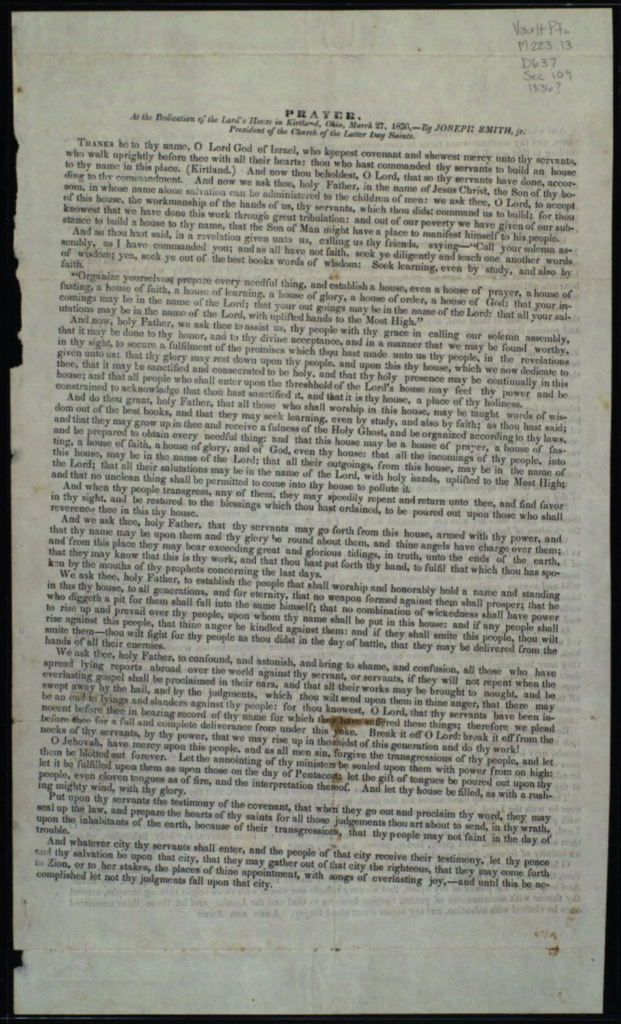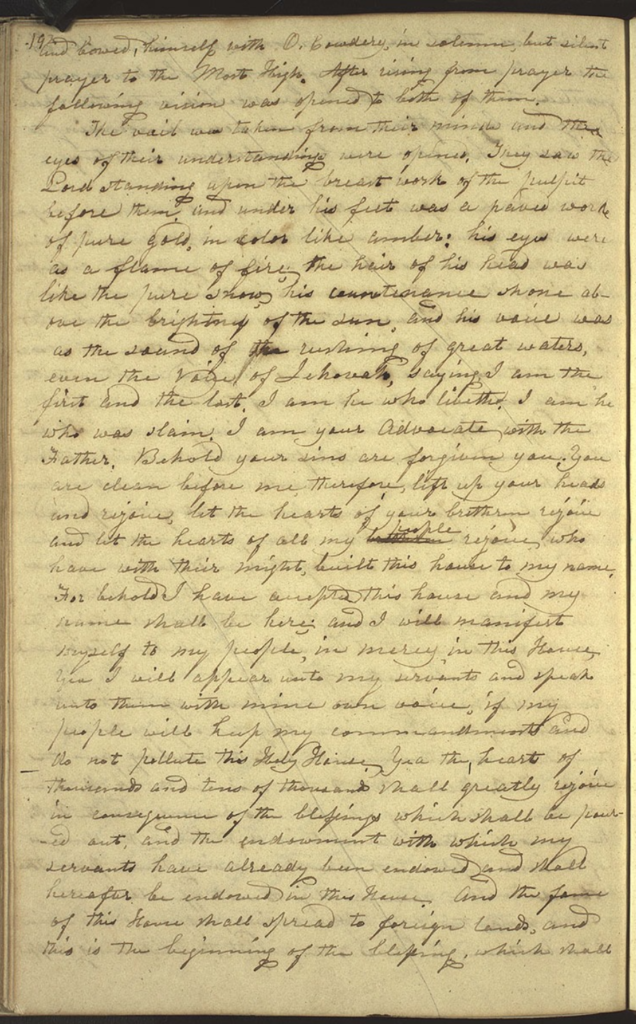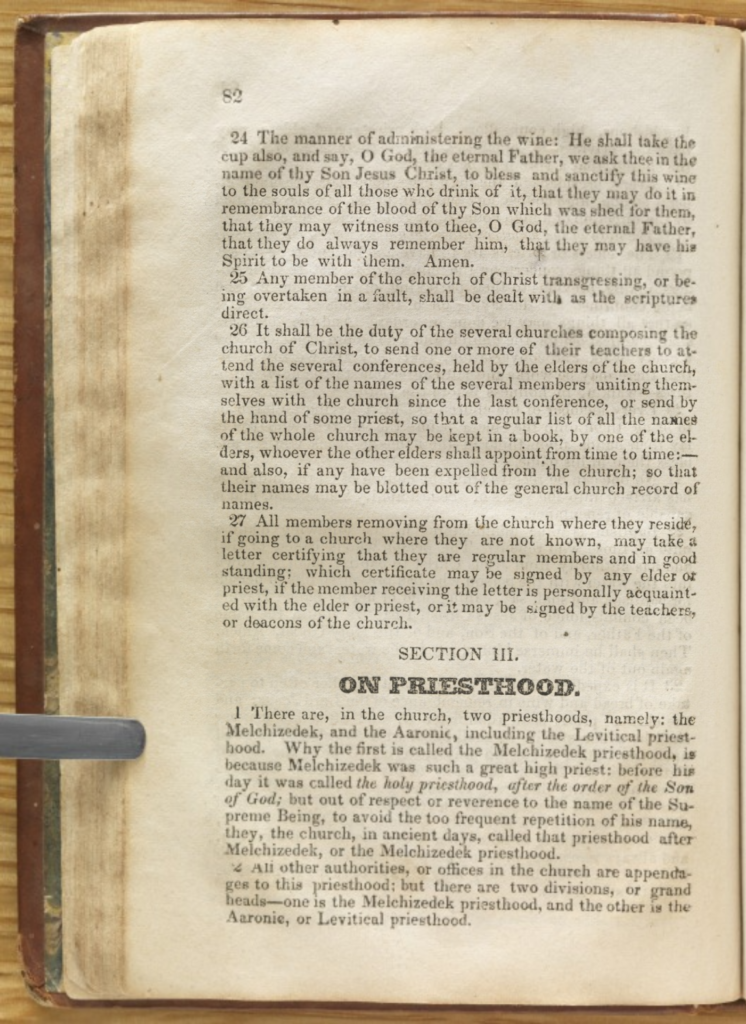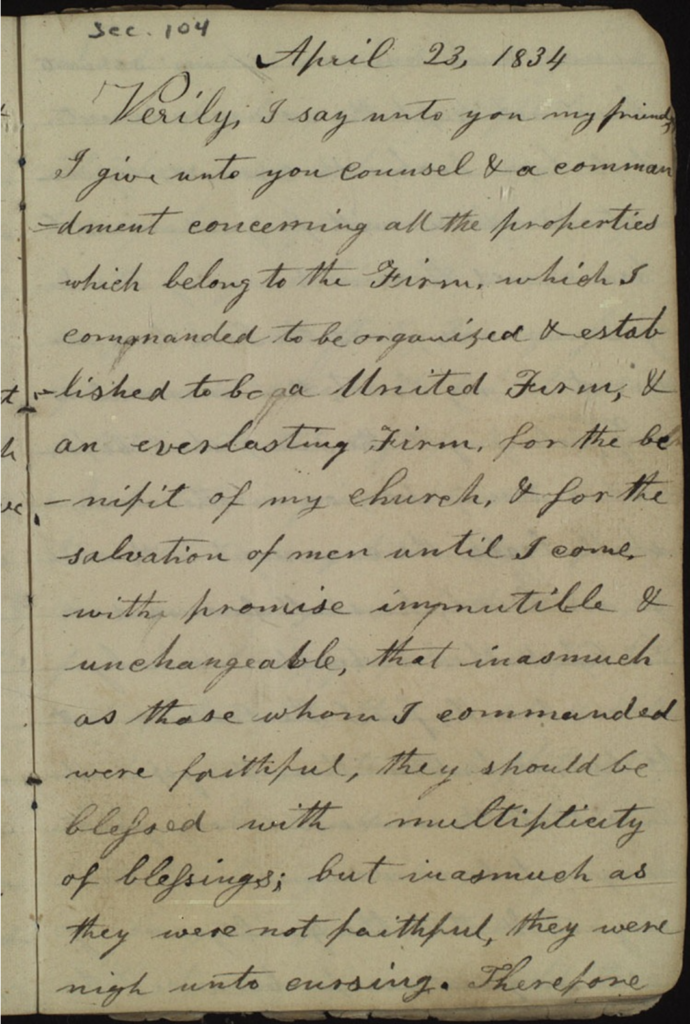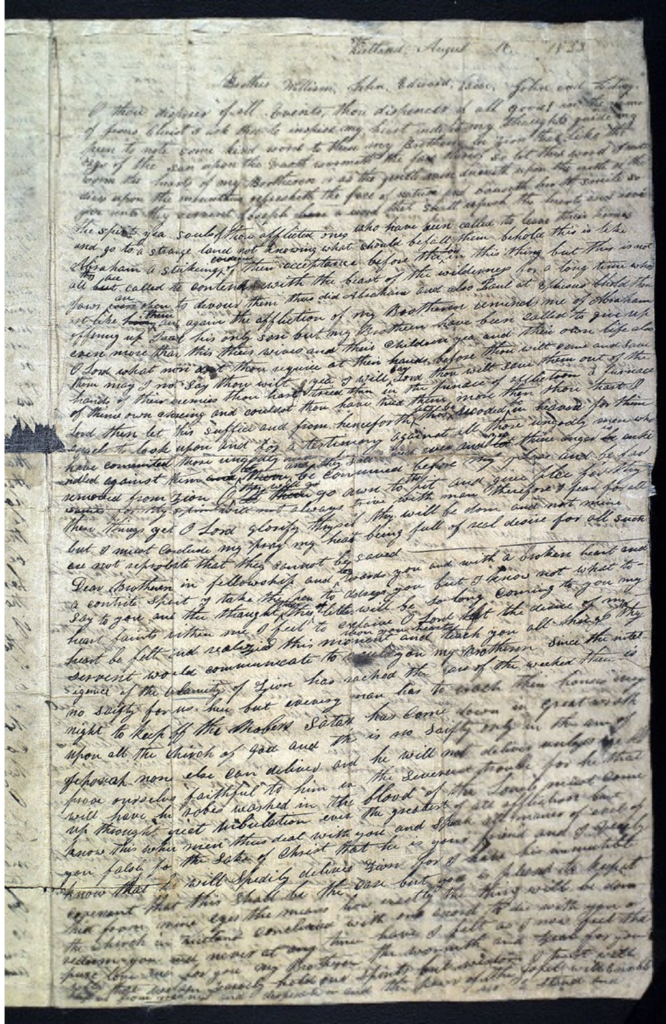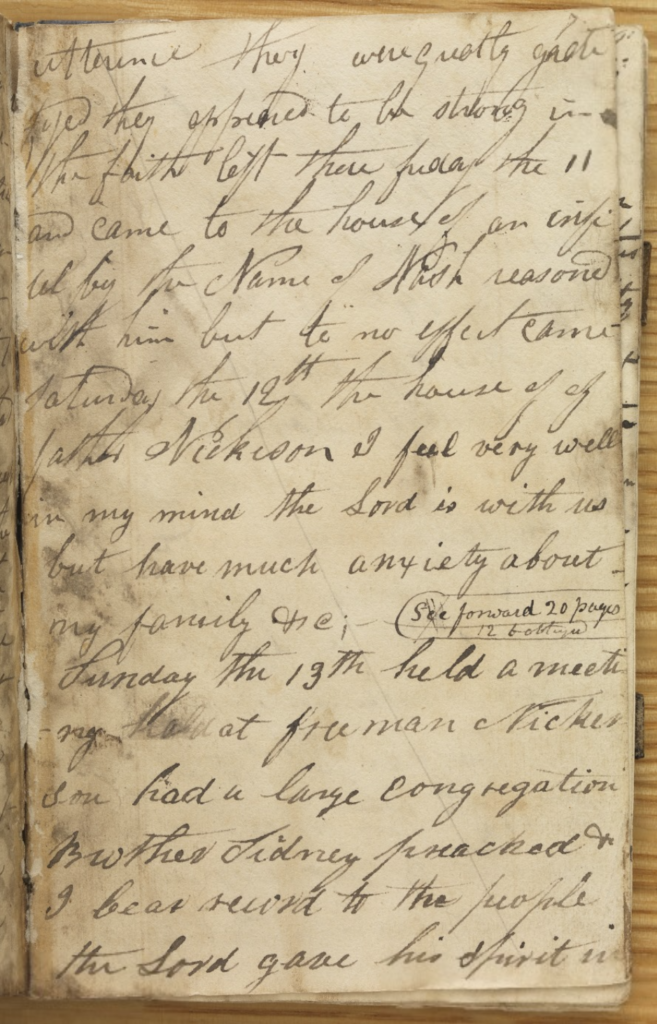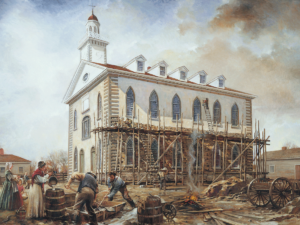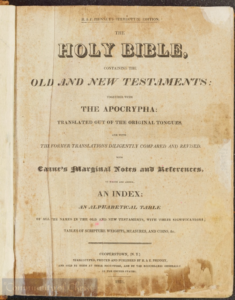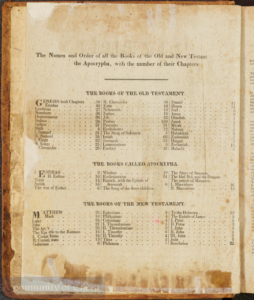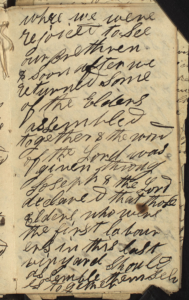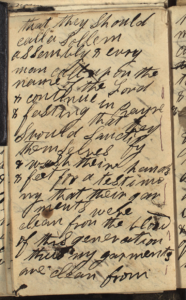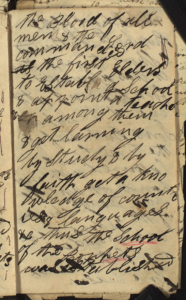Section 115
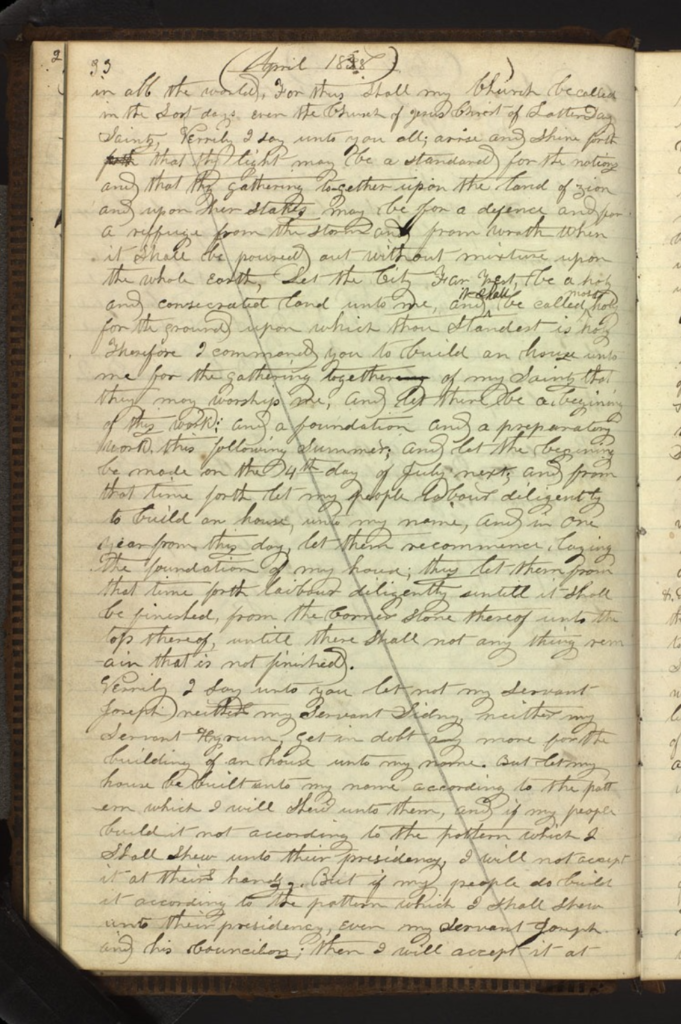
At its organization in on 6 April 1830, The Church was called the “Church of Christ” (see D&C 20:1). Then, beginning on 3 May 1834, Church leaders officially adopted the title, “The Church of the Latter Day Saints.” Section 115 commands that it be called “the Church of Jesus Christ of Latter Day Saints,” a designation Joseph had already begun using.[2]
Shortly after the Lord revealed Section 115, Thomas Marsh, president of the quorum of twelve apostles, wrote of its content to Wilford Woodruff. “Since Br. Joseph came to this place, we have been favored with a lengthy revelation in which many important items are shown forth. First, that the Church, shall hereafter be called. ‘The Church of Jesus Christ of Latter-day Saints.’ Second, it saith ‘Let the City Farwest be a holy and a consecrated land unto me, and it shall be called most holy, for the ground upon which thou standest is holy: Therefore, I command you to build a house unto me, for the gathering together of my Saints, that they may worship me.’ 3d. It also teaches, that the foundation stone must be laid on the 4th of July next, and that a commencement must be made in this following season; and in one year from that time, to continue the work until it is finished. Thus we see that the Lord is more wise than men, for [some] thought to commence it long before this, but it was not the Lords time, therefore, he over threw it, and has appointed his own time. The plan is yet to be shown to the first presidency, and all the Saints, in all the world, are commanded to assist in building the house [of the Lord].”[3]
Section 115 is an optimistic declaration. In the face of overwhelming opposition including indebtedness, persecution, and poverty, the Lord is building Zion. The temple is all important. Having recently received the priesthood keys to authorize temple ordinances (see section 110), Joseph is the Lord’s choice to carry Zion forward, establish its stakes, oversee its temples, and gather the faithful of all nations to be endowed with power.
The Saints gathered on July 4, 1838 to obey Section 115’s command to begin work on the temple. George Robinson, Joseph’s secretary, reported, “We therefore met on this day in Far West Mo. To make our decleration of independence, and to Lay the corrnerstones of the house of the Lord agreeably to the commandment of the Lord unto us given April 26th 1838.”[4] The Saints then gathered building materials so that construction could proceed on 26 April 1839, as the revelation specified. Meanwhile, according to one Missouri historian, the walls inched upwards to nearly three feet before the Saints were driven from the state by the governor’s executive order in the fall.[5]
In obedience to verse 18, Joseph led three expeditions in the spring of 1838 to search out locations for “stakes in the regions round about” (18). Additional explorations were conducted throughout the summer and land surveys conducted in anticipation of more saints arriving in the fall. On June 28, 1838, at a small grove near the home of Lyman Wight near Spring Hill in Daviess County, Joseph Smith organized the Adam-ondi-Ahman stake, the third stake organized in the Church.
Recently the Lord impressed on President Russell M. Nelson’s mind “the importance of the name He decreed for His Church.” President Nelson taught that because of section 115, “the name of the Church is not negotiable. When the Savior clearly states what the name of His Church should be even precedes His declaration with, ‘Thus shall my church be called,’ he is serious.” Using any substitute for the revealed name minimizes or removes the Savior, and “when we discard the Savior’s name, we are subtly disregarding all that Jesus Christ did for us—even His Atonement.” That would not be wise.[6]
Section 116
Shortly after Joseph moved to Far West, Missouri in March 1838, the Lord commanded him that “other places should be appointed for stakes in the regions round about” (see section 115). Anticipating that large numbers of Saints would gather to the area from Ohio, Canada, and elsewhere, Joseph and other leaders set off to explore Daviess County “for the purpose of . . . making Locations & laying claims for the gathering of the Saints for the benefit of the poor.”[1] Near Lyman Wight’s home, Joseph revealed section 116.
Orson Pratt inserted the words “Spring Hill is named by the Lord Adam-ondi-Ahman” when he included this statement in the 1876 edition of the Doctrine and Covenants. The original entry in Joseph’s journal, made by his secretary George Robinson, reads: “Spring Hill a name appropriated by the bretheren present, But afterwards named by the mouth of [the] Lord and was called Adam Ondi Awmen, because said he it is the place where Adam shall come to visit his people, or the Ancient of days shall sit as spoken of by Daniel the Prophet.”[2]
Section116 links the past with the future, sacred history with prophesy. Adam-Ondi-Ahman is a place Adam and Eve went after being expelled from Eden’s Garden. They offered sacrifices and blessed their posterity there. Joseph learned by revelation in 1831 that Adam, prior to his death, gathered his posterity in a valley called Adam-Ondi-Ahman and blessed them and they blessed him. The Lord appeared to them and promised Adam that he would preside over a multitude of nations. Adam rose and, though aged, prophesied what would happen to his posterity (D&C 78:15-16 and 107:53-56).
Section 116 identifies the specific site of that impressive occasion and says that the site will host a future meeting. Adam, or the Ancient of Days, as Daniel called him, will again gather his righteous posterity there, possibly for the sacrament and stewardship meeting prophesied in section 27.
Approximately 1,500 Latter-day Saints settled at Adam-Ondi-Ahman in 1838. They planned a temple. They laid out a stake in obedience to section 115. They obeyed the law of consecration in obedience to section 119.[3] They were driven from the land later that year when Missouri governor Lilburn Boggs issued an executive “extermination” order that effectively enabled Missourians to steal the land by preventing the saints from asserting their preemption rights. Even so, because of section 116, the Church has quietly acquired and preserved the sacred site.
Section 117
To understand section 117, you need to know about a revelation to Joseph that is not in the Doctrine and Covenants. It came to him on January 12, 1838. That year began grimly as dissent from within and opposition from outside the Church pressured Joseph Smith. The saints’ banking project had failed, Joseph was mired in debt because of his efforts to turn Kirtland, Ohio into a stake of Zion, including crowning it with a priceless but nevertheless expensive temple. Creditors, some of whom were Joseph’s avowed enemies, hounded him. Some filed suits against him. Some of his associates and friends rejected his leadership. Dissenters started their own Church.
In that context, Joseph sought direction and received the revelation mentioned above, telling him, his family, and faithful saints emphatically to flee Ohio or Missouri.[1] Joseph left immediately. His family and remaining members of the First Presidency followed him. The question remained whether his “faithful friends” would also. Would they “arise with their families also and get out of this place and gather themselves together unto Zion”?
Joseph moved to Far West, Missouri and received a series of revelations that relocated, reorganized, and reoriented the Church, whose headquarters had been in Kirtland, Ohio since 1831. One of the new revelations, section 115, declared Far West to be the new center of gathering for the Saints.
The First Presidency expected that William Marks, a bookseller who remained in Kirtland to preside over the saints there, and Newel Whitney, the bishop in Kirtland, would obey the revelations to leave Kirtland and come to Far West. These men dragged their feet. Whitney was Kirtland’s most prosperous merchant. He owned a store and a profitably ashery situated ideally near the main intersection through town. He was torn between material prosperity and the revelations.
Almost all the faithful Kirtland saints left for Missouri in May. When neither Whitney nor Marks had arrived in Missouri by July, Joseph received section 117 about their situations and about what to do regarding his indebtedness and the bankruptcy of the First Presidency.
In direct and certain terms, the Lord commanded Newel Whitney and William Marks to relocate to Missouri before winter to continue serving in their respective callings, Marks to preside over the Saints in Far West and Whitney to serve as a bishop, which in the 1830s meant to manage the Church’s material assets to build Zion and relieve poverty.
There is a fascinating dynamic to section 117. No other revelation, no other scriptures in fact, use the words “saith the Lord” as often. Some Old Testament prophets use the phrase nearly as often, and sections 124 and 132 use it frequently too. But its high frequency in section 117 may tell us something about Joseph’s awkward position.
Newel Whitney was his friend and benefactor. Newel and Elizabeth Ann Whitney welcomed the homeless Joseph and Emma to their own hearth when they first moved to Ohio. The Whitneys repeatedly housed Joseph and Emma as well as Sidney Rigdon’s family. Emma gave birth to Joseph III in the Whitney home. Emma and Elizabeth Ann Whitney were dear, close friends. Newel served ably as a bishop and tried to implement the law of consecration. He largely financed the United Firm as one of its charter members (See sections 72, 78, 82, 104). He used his own connections and resources to set Joseph up as a rival storekeeper in Kirtland.[2] Joseph loved and admired Bishop Whitney but acknowledged “the narrow mindedness of his heart and all his covetous desires that so easily besetteth him.”[3]
The Lord speaks directly to those desires in section 117. He speaks as the Creator and Owner of the earth with whom Newel had covenanted to consecrate and serve as a bishop. He commands Newel and William to “repent of all their sins, and of all their covetous desires, before me” (4). He points a series of penetrating questions at the two men who are still deciding whether to serve God or what section 98:20 called “all their detestable things.” The Lord paints a comparative picture, juxtaposing what Joseph called Newel’s “narrow mindedness,” his acquisition of a tiny telestial empire in Kirtland, Ohio, with the Lord’s expansiveness as the creator. He evokes terms from the “pure language” to describe northern Missouri, where Newel is commanded to relocate and serve the saints (117:8, see Section 116 and Abraham 3:13).
In verse 11 the Lord associates Newel Whitney with a Nicolatane band, by which He means to accuse him of aiding and abetting the enemy. Nicolatans were followers of Nicholas of Antioch, an early Christian called and ordained to look after the “business” of ministering to widows (Acts 6:1-8). Nicholas apostatized, however, and led a faction that tried to justify their covetous and lustful impulses.[4] Verse 11 is the Lord’s potent way of conveying to Newel how evil the Lord finds the Kirtland apostates and how near Newel is himself to committing their sins.
Consider the possibility that Joseph may have been discomforted by the Lord’s straightforwardness to Bishop Whitney, who had been so generous with him. There is no way to know for sure, but it may be that Joseph wanted Newel to be sure that the rebuke came from Jesus, not Joseph. That could account for the striking repetition of “saith the Lord” in section 117.
Beginning in verse 12, the Lord commends and commissions Oliver Granger with the job of redeeming the credit of the First Presidency back in Ohio before returning to Missouri as a merchant for Zion. The Lord does not promise Oliver success in this labor, only that his repeated efforts and sacrifice will be sanctifying for him and that his name will be sacredly remembered (13).
Oliver Granger returned from Missouri to Kirtland to obey his part of section 117 by representing the First Presidency in selling some property and settling some debts. One saint on the scene noted Oliver’s “strict integrity” and testified that his “management in the arrangement of the unfinished business of people that have moved to the Far West, in redeeming their pledges and thereby sustaining their integrity, has been truly praiseworthy, and has entitled him to my highest esteem and ever grateful recollection.”[5] Still, “there was not much chance that he could succeed,” Elder Boyd K. Packer taught. He emphasized that section 117 does not praise Oliver for his success but for his efforts, for earnestly contending at personal sacrifice. Thus, for efforts with which Oliver himself may not have been entirely satisfied, his name and example have been remembered.[6]
When Oliver returned from Ohio ready to fulfill the instructions in 117:14, the First Presidency wrote him a letter of commendation.[7] Meanwhile, Oliver delivered section 117 together with a letter from the First Presidency to Newel Whitney and William Marks. The revelation and the related letter put Newel and William in the position of the rich ruler of Luke 18 who kept all of the commandments except the full measure of consecration required to enter the kingdom of God. As Jesus counseled the rich man, so He counsels Newel and William in section 117 to sell what they have; distribute unto the poor; come, in their case literally to Missouri; and choose “treasure in heaven” instead of the comparatively tiny though highly coveted “drop” (117:8, Luke 18:18-25).
The First Presidency’s letter to Newel and William said, “you will understand the will of the Lord concerning you.”[8] Knowing the revelation compelled the brethren to act—either in obedience or disobedience. They could not remain indecisive about obeying Jesus Christ. The First Presidency was confident that they would “doubtless act accordingly,” and they did. Newel Whitney and his family left Kirtland in the fall of 1838, too late to join with the Saints in Missouri (being driven from the state), but soon enough to continue serving as a bishop in Nauvoo, Illinois. William Marks obeyed also and became the Nauvoo stake president.
Section 117 powerfully motivated Newel Whitney, William Marks, and Oliver Granger. Each of them believed it was indeed a revelation from the Lord and sacrificed selfish interests in order to obey it.
Section 118
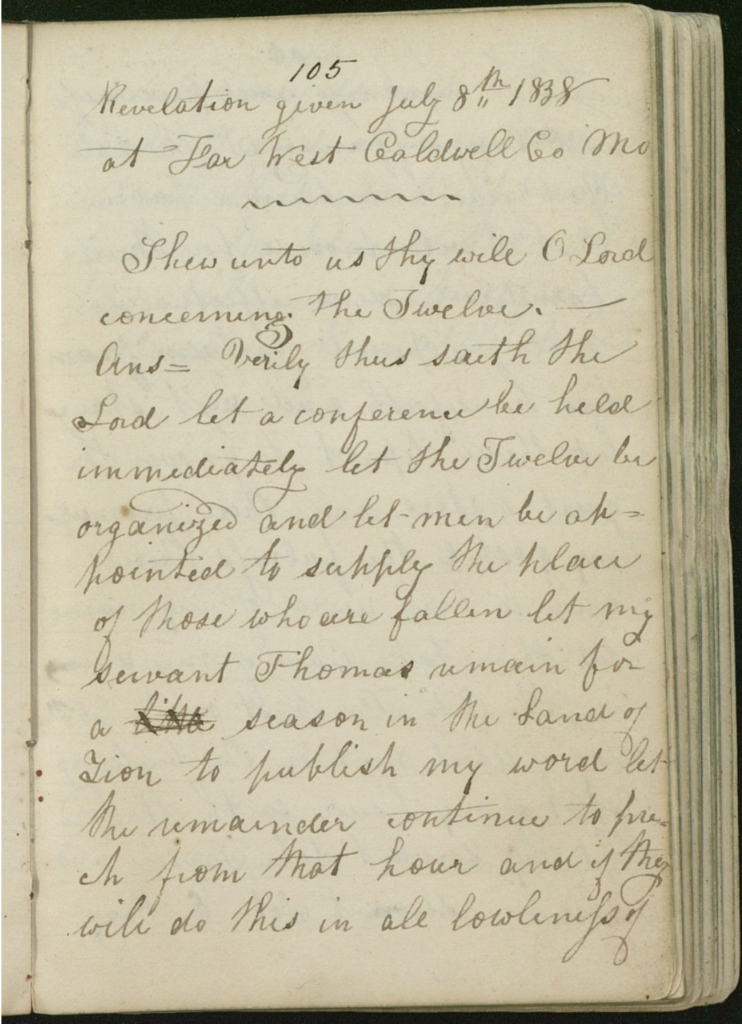
The Lord calls for a conference to immediately fill the vacancies in the quorum of twelve apostles. Thomas Marsh, who besides presiding over the quorum was the Church’s publisher in Missouri, is to continue in that role. The other apostles are to continue preaching. The Lord covenants with them that if they endure in their ministries meekly and humbly, he will provide for their families and give them success.
In verse 4 the Lord elaborates on a call He mentioned in section 114 for the apostles cross the Atlantic Ocean early in 1839 for a mission to Great Britain. This time the call is very specific. “Let them take leave of my saints in the city of Far West, on the twenty-sixth day of April next, on the building spot of my house, saith the Lord” (5). The Lord then names the men He chose to replace the fallen apostles and commands that they be officially notified.
The next day, the apostles who were in Far West met with the First Presidency and acted on section 118’s command to officially notify the new apostles. Sidney Ridgon wrote to Willard Richards, who was already serving in England. Willard was later ordained there by Brigham Young in 1840. Wilford Woodruff was serving in the Islands off the New England coast when, according to his journal, “I received a letter from Thomas B. Marsh, informing me of my appointment to fill the place, in the Quorum of the Twelve, of one who had fallen, and I was requested to come to Far West as soon as possible, to prepare for a mission to England in the spring.”[2]
Obeying the rest of the revelation proved to be more problematic. In October 1838 the governor of Missouri issued an executive order to the state militia to drive the Saints from the state. The Saints lost their property and retreated east to the relative safety of Illinois. There, as April 1839 approached, the apostles and others counseled about section 118’s specific instructions to leave for England from the Far West, Missouri temple site on April 26. Quorum president Thomas Marsh had since been excommunicated for rebellion and apostle David Patten had been killed in the Missouri violence, leaving Brigham Young as the senior apostle.
Wilford Woodruff reported that “as the time drew nigh for the accomplishment of this work, the question arose, ‘What is to be done?’ Here is a revelation commanding the Twelve to be in Far West on the 26th day of April, to lay the cornerstone of the Temple there; it had to be fulfilled. The Missourians had sworn by all the gods of eternity that if every other revelation given through Joseph Smith should be fulfilled, that should not be, for the day and date being given they declared it would fail. The general feeling in the Church, so far as I know, was that, under the circumstances, it was impossible to accomplish the work; and the Lord would accept the will for the deed.”[3] But Brigham Young was presiding over the apostles, and the Lord had commanded them to leave from the Far West temple site on April 16, 1838. Anyone who wonders whether the apostles would do so is probably not familiar with Brigham’s iron resolve.
Wilford joined Brigham Young and others on a journey west over the Mississippi River and into hostile Missouri. Wilford noted that the roads were full of Saints heading east, “fleeing from Missouri to Illinois for they were driven from their houses & lands by the State.” Brigham, Wilford, and their party arrived at Far West on April 25.
In his journal entry for April 16, 1839, Wilford wrote about all the obstacles between the apostles and their revealed instructions to leave for their mission to England from the Far West temple site that day. Then Wilford wrote, “we moved forward to the building spot of the house of the Lord in the City of far west & held a Council & fulfilled the revelation & Commandment.”
Wilford noted that they also fulfilled section 115’s command to begin to lay the foundation for the temple on that day. They rolled a large stone to the southeast corner of the temple site (D&C 115:11). Wilford sat on that stone as the apostles led by Brigham Young ordained him an apostle. George A. Smith was also ordained to replace Thomas Marsh. Each of the apostles prayed and Alpheus Cutler placed the corner stone before, as Wilford put it, “in consequence of the peculiar situation of the Saints he thought it wisdom to adjourn until some future time when the Lord should open the way expressing his determination then to proceed with the building.”[4]
A few days later, William Phelps, who had apostatized and remained in Missouri, reported the event to his wife in a mocking, critical tone. “One of the least of all the forcible tricks of the Mormons, was performed in the morning of the 26th April, in secret darkness about three o clock in the Morning.” He said they “assembled at the big house cellar, and laid one huge stone, in addition to those already there, to fulfill the revelation given the 26th of April one year ago. I think they strained at a camel and swallowed a gnat. . . . I have also learned that, at the sham meeting at the big house cellar, there not being a quorum of the old ‘Twelve’ present, they had recourse to ‘shift,’ and ordained Wilford Woodruff, and Geo. Smith as apostles, which with HC Kimball Orson Pratt, Brigham Young (old ones) and John E Page and John Taylor (new ones), made seven. They prayed (in vain) sung Adam ondi Ahmah, and closed. There were others there. This looks a little like choosing or loving darkness rather than light because their deeds are evil.” Phelps continued with profound irony, “You know I think as much of pure religion as ever, but this foolish mocking disgusts me and all decent people. Force the fulfillment of Jo’s revelation! You might as well damn the waters of Missouri River with a lime riddle. It was undoubtedly done to strengthen the faith of weak members, and for effect abroad: as I understand the Twelve are a going to try their luck again among the nations: It’s really a pity they cannot get a Looking Glass large enough to see the saw log in their own eyes while they are endeavoring to pull the slab out of the neighboring nations. All I can say is ‘Physician save thyself’! Whether you laugh or cry, I have one thing to confess, and that is: I never was so lonesome before.”[5]
While William Phelps pitied himself and mocked the apostles, they turned east and continued to obey section 118. They returned to Illinois to make final preparations for their mission to Great Britain. They left their families sick and destitute and, some suffering from malaria, struggled to make their way to England. There they experienced an unprecedented harvest, converting thousands of souls.
Section 119
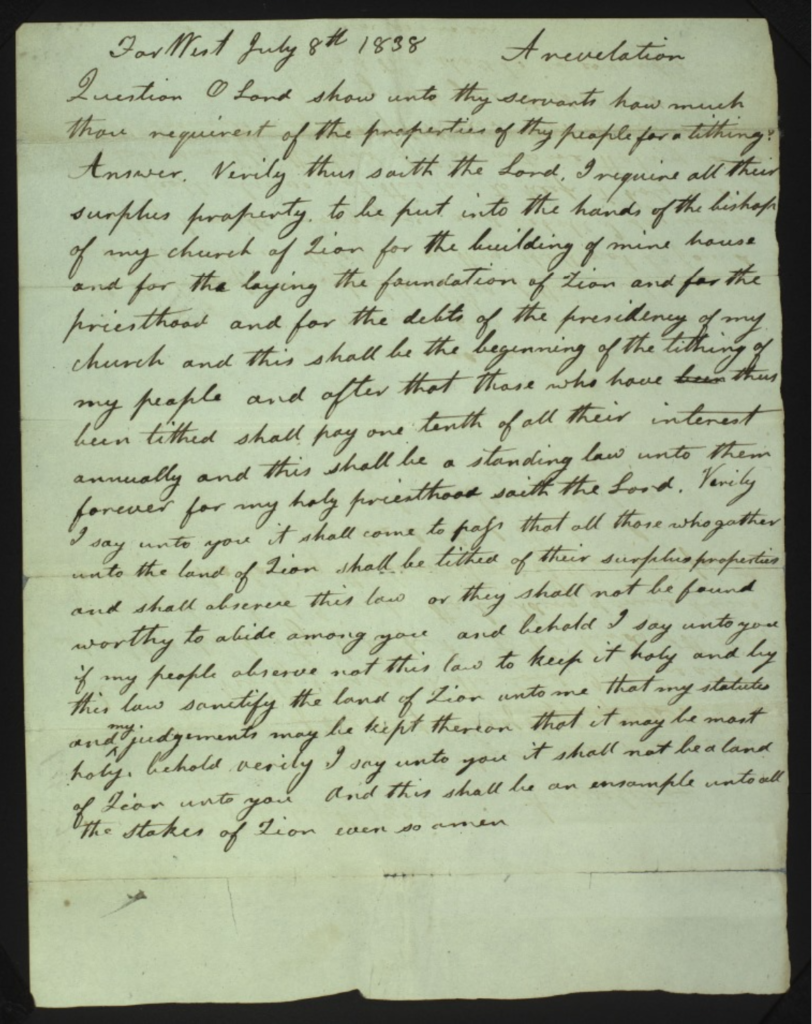
To see how this works, read the revelation in section 119 without looking at the heading. Forget everything you think you know about tithing and just read the revelation. Note that it begins with a direct restatement of the law of consecration (D&C 42:33, 54). Then verse 2 states the reasons for the revelation, and they are the same reasons for the law of consecration and related revelations given in sections 51, 70, 72, 78, 82, 104, and 105. “This,” section 119 says, “is the beginning of the tithing of my people.”
That is the first of the revelation’s three uses of tithing or tithed. All of them refer to the voluntary offering of surplus property. “And after that, those who have thus been tithed,” says verse 4, “shall pay one-tenth of all their interest annually.” Clearly tithing is not a lesser or lower law to be replaced someday but “a standing law unto them forever” and applicable to all saints everywhere (4, 7). The revelation ends with a covenant. “If my people observe not this law, to keep it holy, and by this law sanctify the land of Zion unto me, that my statutes and judgments may be kept thereon, that it may be most holy, behold, verily I say unto you, it shall not be a land of Zion unto you” (6).
So why do saints tell each other the story that the law of consecration is a higher law and tithing is a lower law? The Doctrine and Covenants doesn’t say that. There’s not enough space here to explain this misunderstanding completely but the heading plays a role in it. There are erroneous sentences in the heading that conflict with the revelations in the Doctrine and Covenants: The Lord had previously given to the Church the law of consecration and stewardship of property, which members (chiefly the leading elders) entered into by a covenant that was to be everlasting. Because of failure on the part of many to abide by the covenant, the Lord withdrew it for a time, and gave instead the law of tithing to the whole Church. These sentences conflate two separate, distinct covenants into one, then mistakenly assert that section 119 is instead of that covenant.
The first covenant is the one all saints are to make and keep to live the law of consecration in section 42. Saints were expected, not coerced, to live this law. All could. Some would and some would not. (See sections 51, 66, 85 and 90).
The covenant for all Latter-day Saints to keep the law of consecration is different from the covenant made by the leading elders to own, administer, and share the Church’s assets according to the law of consecration. That second covenant led to the United Firm, better known as the United Order, which existed from 1832 to 1834 and involved a few church leaders, never the general membership of the Church (See sections 78, 82, 104). The Lord declared the United Firm’s covenant broken and therefore void in section 104:4-9. He then dismantled the United Firm in section 104 but never repealed the law of consecration.
President Gordon B. Hinckley taught that that law of consecration was not rescinded and is “still in effect.”[1] So how could section 119 be instead of the law of consecration? The revelation doesn’t say tithing is instead of consecration. It simply restates the law and adds clarification and perhaps even a level of greater obligation. It is best understood as part of, not instead of, the law of consecration. Section 119 is God’s law and covenant to be kept or rejected by each individual’s own free will.
Reading the revelation through broken glasses causes us to distort it to mean that tithing is a lower law that that is going away someday. Seeing the revelation through the lenses of its original context shows us how it fits in the law of consecration, “a standing law unto them forever,” and that obedience to it is prerequisite to Zion (D&C 119).
Section 120
Section 119 created a need to account for the tithes that would be paid as a result of the revelation. Section 120 was revealed to solved that problem. It says that the time has come for the Lord to appoint the First Presidency, bishopric, and high council as a standing council to dispose of the tithes “by mine own voice unto them, saith the Lord.”[1]
Less than a month passed before this newly revealed council met in Far West, Missouri to obey the revelation, that is to “take into concideration the disposing of the publick properties in the hands of the Bishop, in Zion, for the people of Zion have commenced liberally to consecrate agreeably to the revelations, and commandments of the Great I Am of their surplus properties.” The council agreed that the First Presidency should keep all the property they needed “and the remainder be put into the hands of the Bishop or Bishops, agreeably to the commandments, and revelations.”[2]
Section 120 created the council that continues to guide the Church’s financial and property management, and declared the principle of revelation by which they do so. The council has a different composition today, however. When section 120 was revealed, Far West was church headquarters and its bishop and high council served with the First Presidency on the council. Over the years the quorum of twelve apostles grew into a governing body of the Church and a presiding bishopric was formed. Today, in other words, the council is composed of the First Presidency, Quorum of Twelve Apostles, and the Presiding Bishopric.[3]
There have been critics of this council for a long time. Their perspective is always from the outside. Speaking from the inside, with nearly two decades as a member of this council, Elder Robert D. Hales said, “It is remarkable to witness this council heed the Lord’s voice. Each member is aware of and participates in all the council’s decisions. No decision is made until the council is unanimous. All tithing funds are spent for the purposes of the Church.” Elder Hales continued, “I bear my testimony of the Council on the Disposition of the Tithes. . . . Without exception, the tithing funds of this Church have been used for His purposes.”[4]
Section 115 notes
[1] “Minutes, 6 November 1837,” p. 81, The Joseph Smith Papers, accessed December 2, 2020, https://www.josephsmithpapers.org/paper-summary/minutes-6-november-1837/2.
[2] K. Shane Goodwin, “The History of the Name of the Savior’s Church: A Collaborative and Revelatory Process,” BYU Studies Quarterly 58:3 (2019): 5-41.
[3] Thomas B. Marsh to Wilford Woodruff, April 30, 1838, Church History Library, Salt Lake City, Utah.
[4] “Journal, March–September 1838,” p. 46, The Joseph Smith Papers, accessed December 2, 2020, https://www.josephsmithpapers.org/paper-summary/journal-march-september-1838/32.
[5] William A. Wood, “An Old Mormon City in Missouri,” American Magazine of History 16 (1886): 98-99; as cited in Gentry, “A History of the Latter-day Saints in Northern Missouri,” 64, note 77.
[6] Russell M. Nelson, “The Correct Name of the Church,” https://www.churchofjesuschrist.org/study/general-conference/2018/10/the-correct-name-of-the-church?lang=eng.
Section 116 notes
[1] “Journal, March–September 1838,” p. 42, The Joseph Smith Papers, accessed December 2, 2020, https://www.josephsmithpapers.org/paper-summary/journal-march-september-1838/28.
[2] See Daniel chapter 7.
[3] Robert J. Matthews, Adam-ondi-Ahman,” BYU Studies 13:1 (1972): 27-35; Leland H. Gentry, “Adam-ondi-Ahman: A Brief Historical Survey,” BYU Studies 13:4 (1973): 553-76.
Section 117 notes
[1] “Revelation, 12 January 1838–C,” p. [1], The Joseph Smith Papers, accessed December 2, 2020, https://www.josephsmithpapers.org/paper-summary/revelation-12-january-1838-c/1.
[2] Mark L. Staker, “‘Thou Art the Man’: Newel K. Whitney in Ohio,” BYU Studies 42:1 (2003), 75-138, especially page 113.
[3] “Journal, 1835–1836,” p. 6, The Joseph Smith Papers, accessed December 2, 2020, https://www.josephsmithpapers.org/paper-summary/journal-1835-1836/7.
[4] Marvin R. Vincent, Word Studies in the New Testament (Grand Rapids: Wm. B. Erdmans, 1887), 439.
[5] Horace Kingsbury to all persons that are or may be interested, Painesville, Ohio, October 26, 1838, Joseph Smith, Letterbook 2, p. 40, Church History Library, Salt Lake City, Utah.
[6] Boyd K. Packer, “The Least of These,” Ensign (November 2004), 86. Howard W. Hunter, “No Less Serviceable,” Ensign (April 1992), 64.
[7] “Authorization for Oliver Granger, 13 May 1839,” p. 45, The Joseph Smith Papers, accessed December 2, 2020, https://www.josephsmithpapers.org/paper-summary/authorization-for-oliver-granger-13-may-1839/1.
[8] “Letter to William Marks and Newel K. Whitney, 8 July 1838,” p. [1], The Joseph Smith Papers, accessed December 2, 2020, https://www.josephsmithpapers.org/paper-summary/letter-to-william-marks-and-newel-k-whitney-8-july-1838/1.
Section 118 notes
[1] “Revelation, 8 July 1838–A [D&C 118],” p. 105, The Joseph Smith Papers, accessed December 2, 2020, https://www.josephsmithpapers.org/paper-summary/revelation-8-july-1838-a-dc-118/1.
[2] Wilford Woodruff, Journal, August 9, 1838, Church History Library, Salt Lake City, Utah. Thomas B. Marsh to Wilford Woodruff, July 14, 1838, Church History Library, Salt Lake City, Utah.
[3] Wilford Woodruff, Journal of Discourses, 13:159.
[4] Wilford Woodruff, Journal, April 16, 1839, Church History Library, Salt Lake City, Utah.
[5] William W. Phelps to Sally Phelps, May 1, 1839, Church History Library, Salt Lake City, Utah.
Section 119 notes
[1] Teachings of Gordon B. Hinckley (Salt Lake City: Deseret Book, 1997), 639.
Section 120 notes
[1] “Revelation, 8 July 1838–D [D&C 120],” p. 57, The Joseph Smith Papers, accessed December 2, 2020, https://www.josephsmithpapers.org/paper-summary/revelation-8-july-1838-d-dc-120/1.
[2] “Journal, March–September 1838,” p. 59, The Joseph Smith Papers, accessed December 2, 2020, https://www.josephsmithpapers.org/paper-summary/journal-march-september-1838/45.
[3] David W. Smith, “The Development of the Council on the Disposition of the Tithes,” BYU Studies Quarterly 57:2 (2018): 131-155.
[4] Elder Robert Hales, “Tithing,” October 2002 General Conference, https://www.churchofjesuschrist.org/study/general-conference/2002/10/tithing-a-test-of-faith-with-eternal-blessings?lang=eng.

